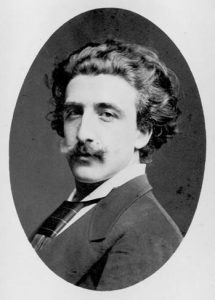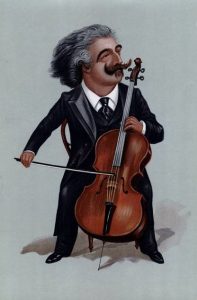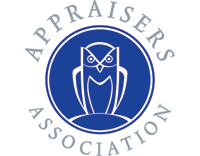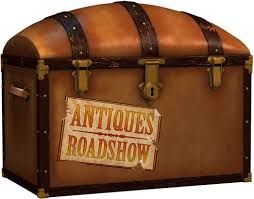Joseph Hollman: “A good cellist” by David Sedlins
This past year Givens Violins’ holiday card featured a print of Joseph Hollman titled “A Good Cellist” from an 1897 edition of Vanity Fair. This title is clearly an understatement. Though Hollman isn’t presently a familiar name within the classical music community, his importance as one of the most celebrated concert cellists of his time must not go overlooked.
Dutch cellist Joseph Corneille Hubert Hollman was born October 16, 1852 in the city of Maastricht. At the age of 14, he was admitted to the Brussels Conservatory, where he studied cello with Adrien-Francois Servais and music composition with Francois-Joseph Fetis and Charles Bosselet. Hollman completed his studies at the Brussels Conservatory at the age of 18 with a first prize. He continued his studies in Paris with Leon Jacquard and then with renowned cellist Karl Davidoff in St. Petersburg. [1]
Early in his professional career, Hollman performed with the orchestra of the Meininger Hoftheater under the direction of Hans von Bulow. In 1887 he settled in Paris as a soloist, where he became one of the most important cellists of his time. Hollman toured extensively throughout Europe, Scandinavia, Russia, America and eventually to China and Japan. [2]
In a review of a London performance in 1888, a listener writes; “Lady Goldsmiid’s beautiful music room has witnessed many interesting musical “events,” this season, but none more noteworthy than the great Dutch violoncellist’s concert…Hollman made his superb Stradivarius sing, and weep, and plead, and coquet, and tell tales of love with a versatility of expression that held his hearers breathless with admiration.” [3]
 Hollman became acquainted with many prominent composers of the time, including Jules Massenet, Eduoard Lalo, Eugene Ysaye and most notably Camille Saint-Saens. During his debut in London in 1885, Saint-Saens performed with Hollman as a duo partner and in 1902 dedicated his cello concerto in D minor op. 119 to him. [4] Joseph Hollman was also a composer in his own right, and often performed his own music during concert tours with great acclaim. A reporter of the Newark Evening News recounts the experience of a 1922 performance; “Mr. Hollman drew from his instrument a tone of great purity…It was translucent, like the atmosphere after rain, while his lower notes were like the open diapason of a great organ. They were controlled with the poise of the matured and eloquent artist…Through his compositions as well as his playing, Mr. Hollman appeals to the intelligence and the eye as well as the emotions.” [5]
Hollman became acquainted with many prominent composers of the time, including Jules Massenet, Eduoard Lalo, Eugene Ysaye and most notably Camille Saint-Saens. During his debut in London in 1885, Saint-Saens performed with Hollman as a duo partner and in 1902 dedicated his cello concerto in D minor op. 119 to him. [4] Joseph Hollman was also a composer in his own right, and often performed his own music during concert tours with great acclaim. A reporter of the Newark Evening News recounts the experience of a 1922 performance; “Mr. Hollman drew from his instrument a tone of great purity…It was translucent, like the atmosphere after rain, while his lower notes were like the open diapason of a great organ. They were controlled with the poise of the matured and eloquent artist…Through his compositions as well as his playing, Mr. Hollman appeals to the intelligence and the eye as well as the emotions.” [5]
Hollman performed with several cellos throughout his career including a Stradivarius, Guarneri and a Vuillaume that was “considered by experts to be the finest specimen of this maker’s work in existence.” [6] Hollman’s favored cello was a 1691 Antonio Stradivarius cello, whose previous owner was Philip of Damian Hoensbroeck, the 13th bishop of Roermond. Later in his life, Hollman’s musical endeavors led him to Japan, where he provided cello lessons to the son of the Emperor. In 1923, at 70 years old, Hollman completed his concert tour in Japan and left the Stradivarius cello as a gift to the imperial court. [7]
In his lifetime, Hollman received numerous awards and honors. The Dutch King William III appointed him Court Chamber Musician and Officer of the Order of the Oak Crown. A year later he became Knight of the Legion of Honor in France. Hollman was also honored as a Knight of the Crown of Mecklenburg-Strelitz and the Japanese Emperor appointed him “officer of the Order of the Rising Sun.” [8]
Joseph Hollman passed away on December 31, 1926. His last wish was to be buried in his hometown of Maastricht. A bust of Hollman remains on display in the vestibule of the old town hall of the city. [9] Several of Hollman’s recordings have survived, including one of Saint-Saens’ The Swan and a 1915 recording of Chopin’s Nocturne in F major, transcribed by Adrien-Francois Servais, which can be heard on Youtube.
Hollman’s cellos represent some of the finest instrument makers in history. Cellos by these legendary makers still serve as models for many contemporary instruments. Givens Violins is delighted to offer a range of cellos modeled after these makers works. Here are a few examples:
Daniele Scolari “Davidov Stradivari” model – $35,000
Topa Workshop “Strad Model” – $16,000
Demeter Petru Christian “Strad model” – $5,900
Jay Haide “Vuillaume model” – $8,900
[1] “Joseph Hollman.” Wikipedia, the free encyclopedia . 19 Aug 2018. Web, 17 Nov. 2018.
[2] “Joseph Hollman.” Wikipedia, the free encyclopedia . 19 Aug 2018. Web, 17 Nov. 2018.
[3] The Theatre. 1 Aug. 1888. Google Books. Web 8 Nov. 2016.
[4] “Hollman, Joseph.” Cellosonate July 2014. Web, 4 Feb. 2019.
[5] “Hollman “The Grand Old Man of the Cello.’” The Music Magazine-musical Courier 7 Dec. 1922. Google Books. Web, 26 Jul. 2013.
[6] Etude: The Music Magazine, Volume 24. 1906. Google Books. Web 27 Feb. 2019.
[7] “Joseph Hollman.” Stichting Maastrichtse Componisten, 2012, www.maastrichtsecomponisten.nl
[8] “Joseph Hollman.” Wikipedia, the free encyclopedia . 19 Aug 2018. Web, 17 Nov. 2018.
[9] “Hollman, Joseph.” Cellosonate July 2014. Web, 4 Feb. 2019.



